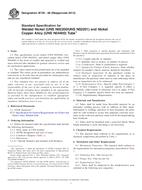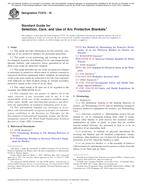1.1 This practice covers the selection of test conditions for accelerated exposure testing of coatings and related products in fluorescent UV and condensation devices conducted according to Practices G151 and G154. This practice also covers the preparation of test specimens, and the evaluation of test results. Table 1 describes commonly used test conditions.
Note 1 – Previous versions of this practice referenced fluorescent UV devices described by Practice , which described very specific equipment designs. Practice has been withdrawn and replaced by Practice G151, which describes performance criteria for all exposure devices that use laboratory light sources, and by Practice G154, which gives requirements for exposing nonmetallic materials in fluorescent UV devices.
Note 2 – ISO 11507:1997 also describes fluorescent UV-condensation exposures of paints and coatings.
1.2 The values stated in SI units are to be regarded as the standard. The values given in parentheses are for information only.
1.3 This standard does not purport to address all of the safety problems associated with its use. It is the responsibility of the user of this standard to establish appropriate safety and health practices and determine the applicability of regulatory limitations prior to use.
TABLE 1 Test Cycles Commonly Used for Fluorescent UV–Condensation Exposure Testing of Paints and Related CoatingsA
| Cycle Number | Cycle Description | 340 nm IrradianceB, C | Black Panel TemperatureD | Typical UsesE |
|---|---|---|---|---|
| 1 | 8 h UV 4 h condensation Repeated continuously |
0.83 W/(m²·nm) dark period |
70 ± 2.5 ºC (158 ± 5 ºF) 50 ± 2.5 ºC (122 ± 5 ºF) |
Automotive coatingsF |
| 2 | 4 h UV 4 h condensation Repeated continuously |
0.89 W/(m²·nm) dark period |
60 ± 2.5 (140 ± 5 ºF) 50 ± 2.5 (122 ± 5 ºF) |
Industrial maintenance coatingsG |
| 3 | 4 h UV 20 h condensation Repeated continuously |
0.89 W/(m²·nm) dark period |
60 ± 2.5 (140 ± 5 ºF) 50 ± 2.5 (122 ± 5 ºF) |
Exterior wood coatings |
| 4 | 8 h UV 4 h condensation Repeated continuously |
0.89 W/(m²·nm) dark period |
60 ± 2.5 (140 ± 5 ºF) 50 ± 2.5 (122 ± 5 ºF) |
General metal coatings |
A The cycles described are not listed in any order indicating importance, and are not necessarily recommended for the applications listed. Additional exposure cycles are described in Practice G154.
B The irradiance set point given is typical for devices operated without irradiance control. Other irradiance levels may be used, but must be described in the report.
C Previous editions of Practice D4587 contained non-mandatory irradiance set points in Table 1 that were commonly used in the industry. The previous set points were 0.72 and 0.77 W/(m² · nm) at 340 nm for UVA 340 lamps. The measurement data used to establish these set points was inaccurate, due to an error in calibration on the part of one manufacturer. It has been found that, for most users, the actual irradiance when running at the previous set points was 11 to 15 % higher than the indicated set point. The set points shown in this edition of D4587 do not change the actual irradiances that have been historically used by these users. However, for users of equipment made by another manufacturer, the irradiance control system did not have the measurement inaccuracies described above, so running at the new set points will represent a change in the actual irradiance of the test. If in doubt, users should consult the manufacturer of their device for clarification.
D Temperature is at equilibrium for either an uninsulated or insulated black panel, although the response of the insulated black panel might be slower than that for the uninsulated black panel. Refer to Practice G151 for more information about the construction and differences between uninsulated and insulated black panels.
E Typical uses do not imply that results from exposures of these materials according to the cycle described will correlate to those from actual use conditions.
F SAE J2020 describes the test used in many automotive specifications and requires use of a FS40 fluorescent UVB lamp.
G Historical convention has established this as a very commonly used test cycle. This cycle may not adequately simulate the effects of outdoor exposure.
^REFERENCE:
ASTM Standards:
D358 Specification for Wood to Be Used as Panels in Weathering Tests of Coatings
D523 Test Method for Specular Gloss
D609 Practice for Preparation of Cold-Rolled Steel Panels for Testing Paint, Varnish, Conversion Coatings, and Related Coating Products
D610 Practice for Evaluating Degree of Rusting on Painted Steel Surfaces
D659 Method of Evaluating Degree of Chalking of Exterior Paints (Withdrawn)
D660 Test Method for Evaluating Degree of Checking of Exterior Paints
D662 Test Method for Evaluating Degree of Erosion of Exterior Paints
D714 Test Method for Evaluating Degree of Blistering of Paints
D772 Test Method for Evaluating Degree of Flaking (Scaling) of Exterior Paints
D823 Practices for Producing Films of Uniform Thickness of Paint, Varnish, and Related Products on Test Panels
D1005 Test Method for Measurement of Dry-Film Thickness of Organic Coatings Using Micrometers
D1186 Test Methods for Nondestructive Measurement of Dry Film Thickness of Nonmagnetic Coatings Applied to a Ferrous Base (Withdrawn)
D1400 Test Method for Nondestructive Measurement of Dry Film Thickness of Nonconductive Coatings Applied to a Nonferrous Metal Base (Withdrawn)
D1729 Practice for Visual Appraisal of Colors and Color Differences of Diffusely-Illuminated Opaque Materials
D1730 Practices for Preparation of Aluminum and Aluminum-Alloy Surfaces for Painting
D2244 Practice for Calculation of Color Tolerances and Color Differences from Instrumentally Measured Color Coordinates
D2616 Test Method for Evaluation of Visual Color Difference With a Gray Scale
D3359 Test Methods for Measuring Adhesion by Tape Test
D3980 Practice for Interlaboratory Testing of Paint and Related Materials (Withdrawn)
D4214 Test Methods for Evaluating the Degree of Chalking of Exterior Paint Films
D5870 Practice for Calculating Property Retention Index of Plastics
E691 Practice for Conducting an Interlaboratory Study to Determine the Precision of a Test Method
E1347 Test Method for Color and Color-Difference Measurement by Tristimulus Colorimetry
G53 Practice for Operating Light- and Water-Exposure Apparatus (Fluorescent UV-Condensation Type) for Exposure of Nonmetallic Materials (Withdrawn)
G113 Terminology Relating to Natural and Artificial Weathering Tests of Nonmetallic Materials
G141 Guide for Addressing Variability in Exposure Testing of Nonmetallic Materials
G147 Practice for Conditioning and Handling of Nonmetallic Materials for Natural and Artificial Weathering Tests
G151 Practice for Exposing Nonmetallic Materials in Accelerated Test Devices that Use Laboratory Light Sources
G154 Practice for Operating Fluorescent Light Apparatus for UV Exposure of Nonmetallic Materials
G169 Guide for Application of Basic Statistical Methods to Weathering Tests
ISO Standard:
ISO 11507:1997 Paints and Varnishes-Exposure of Coatings to Artificial Weathering-Exposure to Fluorescent UV and Water
SAE Standard:
SAE J2020 Accelerated Exposure of Automotive Exterior Materials Using a Fluorescent UV Condensation Apparatus
Product Details
- Published:
- 06/01/2011
- Number of Pages:
- 6
- File Size:
- 1 file , 120 KB
- Redline File Size:
- 2 files , 200 KB


